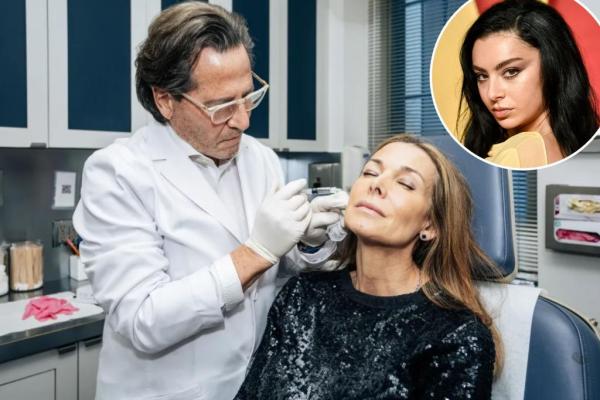
There’s nothing fishy about this skin care secret — unless you count the ingredients.
The pursuit of plastic-free perfection has led beauty buffs on a hunt for nonsurgical alternatives — and the promise of one new cutting-edge approach is prompting some doctors to skirt federal regulations.
New Yorker Cortny R., for instance, refuses to go under the knife.
“I don’t want to have plastic surgery. I’m not at that point yet. I want to just look my best, feel my best,” Cortny, who declined to provide her last name, told The Post, adding that she wants to “age gracefully.”
Instead, the 57-year-old opts for noninvasive alternatives, like lasers, Botox and, most recently, polynucleotide injections — derived from the gonads of trout and salmon — which improve complexion, tackle signs of aging and, according to Cortny, make skin “radiant.”
And she’s in good company. Polynucleotides got a major plug when pop sensation Charli xcx32, confessed she’d ditched artificial injectables like filler and Botox in favor of the new-age treatment, which can cost upward of $1,000 at certain clinics in the UK. The “Brat” hitmaker joins the ranks of beauty-obsessed A-listers who have recently denounced the use of facial filler.
Board-certified dermatologist Dr. Rachel Nazarian plans to offer polynucleotide treatments in her Manhattan practice soon.
“I’m very cautiously optimistic about this,” Nazarian told The Post. “And if you look at the literatureI think there’s a lot of reason that we should be.”
When polynucleotides — strands of DNA — are injected into the skin, they send signals telling the body to regenerate healthy cells. The treatment, which requires multiple sessions, results in boosted hydration, elasticity and plumpness in the skin, while decreasing the appearance of fine lines and wrinkles.
“The reason these are gaining popularity is because they’re more of a skin booster,” board-certified plastic and reconstructive surgeon Dr. Catherine Chang told The Post.
“You’re stimulating the body to improve different aspects — improving collagen, improving elasticity — and I think that’s really interesting because everything we have right now is more additive,” said Chang, founder of Privé Beverly Hills and NakedBeauty MD.
Filler adds volume to the face by injecting hyaluronic acid into the desired area, with plumping results that last up to a year. Skin boosters, such as polynucleotides, are “stimulatory,” giving skin the instruction to improve on its own — a developing area of aesthetics that Chang believes is “very promising.”
NYC-based nurse practitioner Evangelia Nezis, 37, is constantly in pursuit of finding new ways to stave off aging while still looking like herself.
“I’m always into what’s new out there that’s not a filler,” she told The Post. “What else can I do that isn’t going to alter too much my face and just improve it?”
Filler, she said, is often “overdone,” but remains popular due to offering “instant gratification.” Skin rejuvenation treatments like polynucleotides are a slow burn that require multiple sessions, but the result, she said, is a more natural look. Since injecting polynucleotides on herself six months ago, she has already seen a reduction in fine lines, improved skin texture and complexion, less redness and “an overall glow.”
Polynucleotides soared to popularity in South Korea and Europe before bursting onto the US skin care scene, initially administered topically after laser or microneedling treatments, tacking on an extra $350 or more at certain NYC clinics. Injections of polynucleotides, however, are not approved by the Food and Drug Administration, multiple doctors told The Post, but are gaining traction as an off-label use.
“I always want to be ahead of the curve,” board-certified Park Avenue dermatologist Dr. Howard Sobel told The Post.
He is currently offering injections to friends, family and a select few patients, such as Cortny, and plans to introduce injections to his practice in the coming months. He’ll charge between from $750 and $1,200, depending on how they’re used.
“The results have been dramatic, widespread throughout Europe and Asia where it’s officially approved, but the FDA here in the United States is much more stringent and much more difficult to get things approved,” Sobel said.
“There are a lot of things that we do here in the States as doctors that are off-label,” he continued. “Off-label, what it means is, it’s been shown in numerous studies to be beneficial.”
But some doctors are taking a more conservative approach, such as NYC facial plastic surgeon Dr. Richard Westreich. He told The Post he is waiting to offer polynucleotide injections until they’re cleared by the health agency — but once approved, he’ll start injecting.
“In international markets like Korea and other places, certainly injection is commonplace, and it stands to reason that if we can see really great results from topical administration post-procedure, that injection would even be better,” California dermatologist Dr. Saami Khalifian told The Post.
Patients who have lost volume in their face due to age or other factors might still need filler, but that doesn’t provide any anti-aging effects that a treatment such as polynucleotides can.
In other words, you can pump your face with filler or inject Botox to ward off wrinkles, but if “skin quality is not good,” said Khalifian, “it still doesn’t look good.”